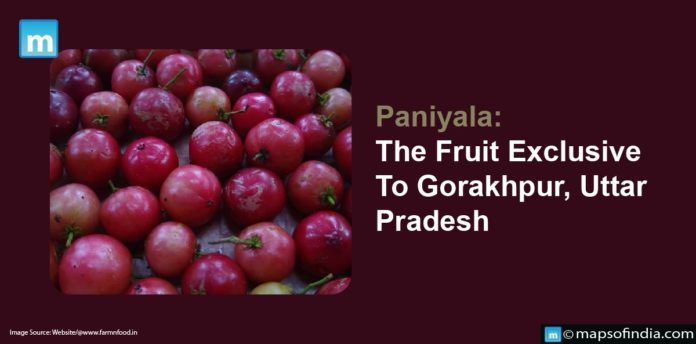Nestled in the heartland of India, Gorakhpur in Uttar Pradesh is a city that boasts a rich historical and cultural heritage and is also home to a unique and enigmatic fruit known as “Paniyala”. The Paniyala is a small, round fruit with a golden yellow skin and sweet, juicy flesh. It is native to the Gorakhpur district of Uttar Pradesh, India, and is said to be found nowhere else in the world. The Paniyala is a member of the Annonaceae family, including custard apples, soursops, and cherimoyas. The fruit is about the size of a golf ball and has a rough, bumpy skin. The flesh is white and has a custard-like consistency. The Paniyala has a sweet, slightly acidic flavor and is often eaten fresh.
With its distinct flavor and local significance, this extraordinary fruit has become synonymous with the region, earning itself a Geographical Indication (GI) tag that recognizes and protects its exclusivity.
Cultural Significance
Paniyala is more than just a fruit in Gorakhpur; it represents the region’s agricultural prowess and cultural identity. The fruit has made its way into local rituals, celebrations, and traditional recipes and has become an essential part of the community’s way of life. Paniyala is frequently exchanged as a gesture of goodwill and prosperity during festivals and special occasions. The fruit’s distinct flavor and texture make it a popular ingredient in local cuisine, appearing prominently in desserts, salads, and refreshing beverages.
Cultivation and Harvesting
Paniyala cultivation is a meticulous process that requires close attention to the region’s climate and soil conditions. The fruit is primarily grown in the fertile plains surrounding the city, which benefit from the rich alluvial soil deposited by the region’s rivers. Paniyala trees thrive in the local climate, which features hot summers and mild winters. Farmers use traditional methods passed down through generations to determine the optimal harvesting time when the fruit ripens in summer. Paniyala harvesting is delicate because the fruit is easily damaged if handled roughly. The cultivation skills and knowledge required have been honed over decades, contributing to the fruit’s exclusivity and distinct quality.
Health Benefits and Nutritional Value
Paniyala has numerous health benefits in addition to its distinct flavor and cultural significance. The fruit’s high water content makes it a refreshing and hydrating snack, especially during the hot summer. Furthermore, Paniyala is high in vitamins and antioxidants, making it a nutritious addition to one’s diet. Local traditional medicine systems frequently emphasize Paniyala’s therapeutic properties, attributing it with qualities that aid digestion, boost immunity, and promote overall well-being.
The Journey to GI Tag
Paniyala was granted a Geographical Indication (GI) label on January 29th, 2023, recognizing its exclusivity and cultural significance. This legal recognition emphasizes the fruit’s geographical origin and protects its uniqueness from imitation and misuse. The GI designation not only recognizes the traditional knowledge and craftsmanship of local farmers, but it also opens up opportunities for economic growth. Paniyala is now recognized as Gorakhpur’s flagship product, attracting attention and demand from both domestic and international markets.
Conclusion
Paniyala, the enigmatic fruit exclusive to Gorakhpur, Uttar Pradesh, is more than just a culinary delight; it is a testament to the deep-rooted connection between a community and its land. With its Geographical Indication tag, Paniyala symbolises local pride, cultural heritage, and agricultural ingenuity.





